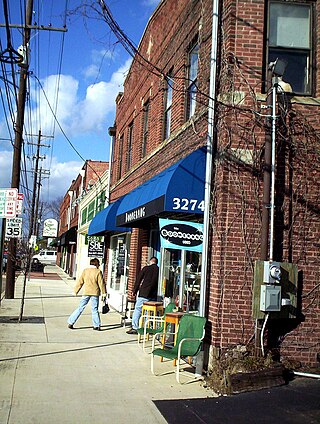
Clintonville is a suburban neighborhood in north-central Columbus, Ohio, United States with around 30,000 residents. Its borders, associated with the Clintonville Area Commission, are the Olentangy River on the west, Glen Echo Creek to the south, a set of railroad tracks to the east, and on the north by the Worthington city limits.
The Near East Side is a neighborhood located near downtown Columbus, Ohio, made up of several neighborhoods: Mount Vernon, King-Lincoln Bronzeville, Eastgate, Franklin Park, Nelson Park, Olde Towne East, and Woodland Park.
Columbus, the state capital and Ohio's largest city, has numerous neighborhoods within its city limits. Neighborhood names and boundaries are not officially defined. They may vary or change from time to time due to demographic and economic variables.
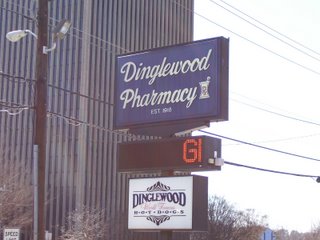
Dinglewood is a neighborhood/subdistrict located at the southern edge of Midtown Columbus, Georgia. In it is the tallest building in Columbus, the Aflac Tower. It is also home to the famous Dinglewood Pharmacy, which serves, in the opinions of the city's residents, the city's best scrambled hot dog. The boundaries of the neighborhood are generally acknowledged to be 17th Street to the north, Martin Luther King Jr. Boulevard to the south, Interstate 185 to the east and Veterans Parkway to the west. In 2007, the estimated population of the area was 1,101.

The Enid Downtown Historic District is located in Enid, Oklahoma and listed on the National Register of Historic Places since 2007. In 2019 the district was expanded from 7 blocks to 21. The district includes the original downtown plat from 1893, part of the Jonesville addition plat from 1898, and part of the Weatherly addition plat from 1902.

The United States Post Office and Courthouse is a historic building in Downtown Columbus, Ohio. The structure was built from 1884 to 1887 as the city's main post office. The building also served as a courthouse of the United States District Court for the Southern District of Ohio from its completion in 1887 until 1934, when the court moved to the Joseph P. Kinneary United States Courthouse. The building was tripled in size from 1907 to 1912, and was rehabilitated for use as the Bricker & Eckler law offices in 1986, and today houses the same law firm.

The Columbus Foundation is a nonprofit charitable organization in Columbus, Ohio, founded in 1943.

The Whitney Park Historic District is a residential historic district on the west side of Bangor, Maine. The district contains 42 residential properties built between 1850 and 1910, a major period of the city's growth, and is anchored on its south by Whitney Park, a small triangular park at Hammond and Cedar Streets. The district was listed on the National Register of Historic Places in 1988, and is protected by the city's local historic district ordinance.

The Richard Berry Jr. House is a historic house in the Clintonville neighborhood of Columbus, Ohio, United States. The house was listed on the National Register of Historic Places in 2005 and the Columbus Register of Historic Properties in 2006. The house is also a part of the East North Broadway Historic District, listed on the National Register in 2010. It is a well-preserved example of early 20th century Colonial Revival houses. It was built in 1926 and designed by Columbus architect Ray Sims.
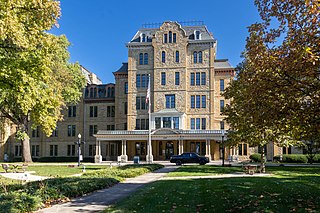
Columbus Public Health is the health department of Columbus, Ohio. The department is accredited by the Public Health Accreditation Board. The department dates to 1833, when the city's mayor appointed five citizens to help with its cholera outbreak. It became a permanent body to activate whenever health emergencies arose.
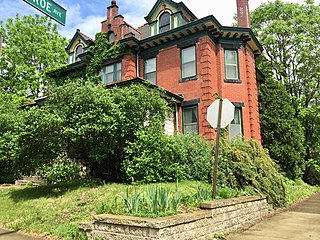
The Columbus Near East Side District is a historic district in the Near East Side of Columbus, Ohio. The site was listed on the National Register of Historic Places in 1978. A portion of the district, the Bryden Road District, was added to the Columbus Register of Historic Properties in 1990. An addition, the Columbus Near East Side Historic District-Parsons Avenue, was added to the register in 1983.

The East Town Street Historic District is a historic district in Downtown Columbus, Ohio. The site was listed on the National Register of Historic Places in 1976 and the Columbus Register of Historic Properties in 1982; the district boundaries differ between the two entries.

The Iuka Ravine Historic District is a historic district in the University District of Columbus, Ohio. The site was listed on the Columbus Register of Historic Properties in 1985 and the National Register of Historic Places in 1986. The district has approximately 50 houses and apartment buildings, most located on the edge of the wooded Iuka Ravine. The houses are mostly craftsman and early 20th century revival styles, with noted Columbus architects Frank Packard and Charles Inscho represented. The district was the first development in the city to take advantage of its natural landscape, setting an example for other early 20th century developments around Columbus.

The Felton School was a public school building in the Mount Vernon neighborhood of Columbus, Ohio, and a part of the Columbus Public School District. It was listed on the National Register of Historic Places in 1984 and the Columbus Register of Historic Properties in 1985.

The East Broad Street Commercial Building is a historic building in Columbus, Ohio. It was built in 1930 and listed as part of the E. Broad St. Multiple Resources Area on the National Register of Historic Places in 1986. The building has served numerous businesses, including doctor's offices, insurance agencies, and a Kroger store (1930-1946). Chinese restaurants operated out of the building from 1930 to 1995: Golden Lotus from 1930 to 1950 and Jong Mea from 1950 to 1995.
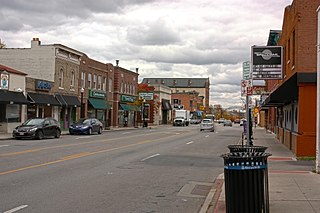
The North Columbus Commercial Historic District is a historic district in the Old North Columbus neighborhood of Columbus, Ohio. It was listed on the National Register of Historic Places in 2010. The district is centered on High Street, one of the city's two main thoroughfares. The district has 25 buildings, all of which contribute to the district, and built from c. 1880 to 1960. Architectural styles range from Italianate to Tudor Revival and Neoclassical, with some Craftsman elements and one Modernist building.

The Hanford Village George Washington Carver Addition Historic District is a historic district in the Hanford Village neighborhood of Columbus, Ohio. It was listed on the National Register of Historic Places in 2013. At the time of nomination, the site consisted of 95 buildings, sites, or structures, 76 of which are contributing. Most are one-and-a-half-story gabled Cape Cod houses with simplified Colonial Revival features.

The Near Northside Historic District is a historic district in Columbus, Ohio. The large district encompasses portions of the University District, Harrison West, and nearly all of Victorian Village.
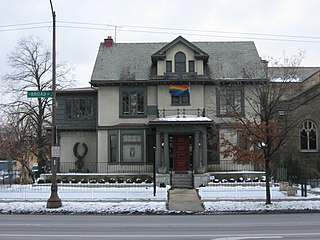
The Carrie Lovejoy House is a historic house in Columbus, Ohio, United States. The house was built c. 1900 and was listed on the National Register of Historic Places in 1986. The Carrie Lovejoy House was built at a time when East Broad Street was a tree-lined avenue featuring the most ornate houses in Columbus; the house reflects the character of the area at the time.

The Theresa Building is a historic building in the King-Lincoln Bronzeville neighborhood of Columbus, Ohio. It was built in 1925 and was listed on the National Register of Historic Places in 2015.





















